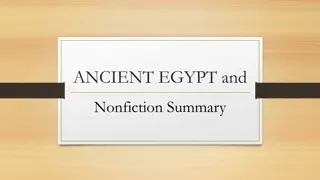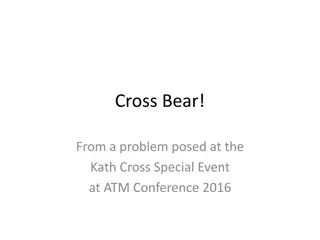Egyptian Mummification and Attitudes Towards the Afterlife
The ancient Egyptians practiced mummification to preserve bodies for the afterlife. They believed in ensuring the deceased had everything they needed in the next world, including food, pets, and possessions. The process evolved over thousands of years, with rich and poor individuals being mummified differently. Animals, such as cats and dogs, were also mummified as offerings to the gods. This practice reflects the Egyptian beliefs in the afterlife and the importance of preserving not just human but also animal bodies for eternity.
Download Presentation

Please find below an Image/Link to download the presentation.
The content on the website is provided AS IS for your information and personal use only. It may not be sold, licensed, or shared on other websites without obtaining consent from the author.If you encounter any issues during the download, it is possible that the publisher has removed the file from their server.
You are allowed to download the files provided on this website for personal or commercial use, subject to the condition that they are used lawfully. All files are the property of their respective owners.
The content on the website is provided AS IS for your information and personal use only. It may not be sold, licensed, or shared on other websites without obtaining consent from the author.
E N D
Presentation Transcript
List 3 points on your table What do you know about Egypt mummification and attitudes towards the afterlife?
The Egyptians mummified bodies from 4,500 years ago until about 1,500 years ago. The earliest Egyptians buried their dead in shallow pits in the desert. The hot, dry sand quickly removed moisture from the dead body and created a natural mummy. However, the Egyptians discovered that if the body was first placed in a coffin, it would not be preserved. In order to ensure that the body was preserved the Ancient Egyptians began to use a process called mummification. This involved embalming the body and then wrapping it in thin strips of linen. Ancient Egyptians often placed food and even beloved pets (also mummified) into the coffins to travel to the afterlife with the dead people.
Use ipads/ phones Egyptian after-life test what was it?
Herodotus extract 1. What were the differences in mummification for rich and poor? 2. What was there evidence of one embalmer doing?
Animal Mummies! Although humans have been the main subjects for mummification, animals were also mummified too. Many of the mummies found were animals that were cherished pets or mummies used as offerings to the gods. Such animals included cats, monkeys and hawks. he pets were depicted on tomb walls and were shown eating food or sitting under the chair of the deceased owner.
Animal mummies???? Egyptians often mummified other animals, such as cats and dogs. Also point out that the cat sarcophagus is similar to a coffin that we might use today. Why do people in ancient and modern times like to preserve the bodies of their pets. How do we honor our pets today when they die?























